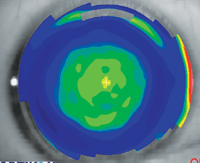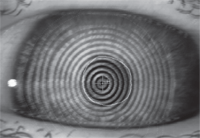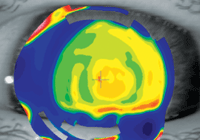There are a number of reasons why patients drop out of contact lens wear. Discomfort, of course, is one major reason. But decreased visual acuity due to presbyopia is another major concern.

This is a topography over a center near aspheric soft multifocal contact lens. The small cross hair in the center of the topography represents the patient’s line of sight. In this eye, the optics of the multifocal contact lens are lined up well over the visual axis.
And, it’s not a concern we should shy away from. We have the opportunity to help our presbyopic patients function in their environment without the need for glasses. How? By offering multifocal contact lenses.
Among a survey of 500 presbyopic patients, only 8% of those currently wearing contact lenses were educated about multifocal contacts.1 We need to educate presbyopes about these options so that we can find a mutually agreed-upon treatment based on the patient’s needs and the practitioner’s professional judgment.
By discussing multifocals and the benefits they may offer, you do two things: You offer the patient a truly customized approach to vision correction; and you separate your practice as one that emphasizes the newest technologies.
However, one of the major complaints of fitting multifocal contact lenses is the numerous follow-up visits that seem to be required. Patients don’t like coming back again and again, so we need to focus on efficient techniques to minimize follow-up and to maximize success.
Defining Success
One of the hurdles to multifocal success is managing patient’s expectations and excitement. A patient’s excitement about wearing multifocal contact lenses rarely matches the subdued interest of their optometrist. Often, a patient has heard about multifocal contact lenses from a friend or family member—and only occasionally from their eye care professional.
When they inquire about the possibility of wearing this technology, their eye doctor often responds with some trepidation. There are many reasons this can happen. And if it happens in your practice, ask yourself a few questions:
• How many multifocal patients do you fit annually? Set some goals for 2012 and aim high.
• Do you proactively recommend multifocal lenses or do you wait for the patient to inquire? If you offer them to patients and let patients know they are great candidates for this technology, it will generate more excitement.
• Why would you fit multifocal lenses? Is it because of the intermediate vision, flexibility with designs, binocular vision improvements
and/or the differentiation your practice can receive?
• Does your staff proactively recommend multifocal lenses? And, are they able to help set the stage for the doctor when he or she comes into the room?
A positive attitude goes a long way, and it often reaps positive results. So, when developing your protocol and fitting philosophies with multifocal contact lenses, first consider the key factors that create positive outcomes with these lenses.
The first key factor is good communication skills. Eye care professionals need to have good communication skills in order to be successful with multifocal contact lenses. (See “How to Get the Multifocal Message Across.")
The second key factor is good fitting skills. Be creative. It’s important to understand the difference in each design of multifocal lens and ways to be successful with each. Success is not defined as wearing two multifocal lenses at completion. Be ready to fall back to a modified multifocal lens fit—it’s not uncommon to fall back about one-third of the time, in our experience. It really depends on what patients want and how they use their eyes on a daily basis.
Identify Needs
When interviewing patients, it is important to determine their specific needs. Find out about your presbyopic patients’ occupations, hobbies and daily visual requirements in order to educate them properly on their available options. Listen to their needs and customize the lenses to match their needs.
For example, one patient may spend 14 hours a day on the computer and want to maximize his intermediate and near vision. This may be a key piece of information when deciding which multifocal contact lens to fit.
Control Patient Expectations
The other side of the coin in identifying patient needs is managing patient expectations. To that end, consider these two questions:
1. What is the most effective way of setting patient expectations?
Keep current on presbyopic contact lenses in order to present options in a positive way, while setting realistic expectations. For example, try to communicate presbyopic fitting in such a way as to avoid the words “compromise” or “loss of vision.” Instead, describe multifocal lenses as “customized” or “balanced” according to each patient’s visual system.
Remember the key technique is to under-promise and over-deliver. Let them know they may need reading glasses for small print. If they don’t, then you are their hero. Let them know these lenses can provide good vision for 90% of their visual needs, but there may be some loss of crispness 10% of the time. If the patient needs readers to see the phone book or medicine bottles, then this tactic is successful. Gauge their interest and describe the expected fitting timeline and appropriate fees up front.
2. What is most effective in explaining adaptation to multifocal lenses?
It is important to talk about adaptation to everyone, but don’t make a big deal about it. Let them know it will take a little while for their eyes to adapt to this design, just like a new pair of spectacles. It may even take from four to six weeks for their eyes to adjust. Set the first follow-up appointment for one week and make adjustments as needed.
The Dispensing Visit
Near visual acuity is not always a good predictor of success with multifocal contact lenses. However, the next time you fit a patient with multifocal contact lenses, consider a practical test to demonstrate functional improvement with the lenses: Tell the patient to look at his or her cell phone, and ask how well he or she can see the numbers. By allowing patients to see the instant improvement in vision with something that they utilize every day, they will be more likely to realize the functionality that this modality can offer.
Consider these strategies at the dispensing visit in order to save time and minimize follow-up appointments later down the road:
1. Always know eye dominance up front. This will enable minor adjustments independently down the road.
2. After allowing the multifocal lenses to settle for 10 to 15 minutes at the initial visit, make minor adjustments. Err on the side of more distance to start.
3. Utilize staff. Your staff can improve efficiency by measuring visual acuities. You may also consider allowing them to assess the fit.
Topography Over Contacts?
An interesting lecture by Patrick Caroline, C.O.T., and a follow-up conversation with him and Matthew Lampa, O.D., fundamentally changed the way we position topography in our practice for multifocal contact lens wearers. Lens centration is a critical component to contact lens wearing success. This begs the question: Is centration over the pupil or the visual axis required to maximize multifocal success?
Angle kappa, which is the difference between the visual axis and the pupillary axis, does not play a significant role in the success of single vision contacts because of a consistent power profile across the optical zone of the lens. But a multifocal contact lens becomes much more dependent on centration over the visual axis.
The question then becomes: How do we determine if the multifocal contact lens optics are centered over the visual axis and will it play a role in how we fit multifocal lenses? A lens that appears to be centered on the eye when assessing the fit with a slit lamp may not necessarily be optimally aligned if a patient’s line of sight is not aligned with the center of the pupil.
An interesting study recently assessed multifocal contact lens centration with the aid of corneal topography, and compared it to the patient’s line of sight.2 This was accomplished by understanding that the center ring of the videokeratoscopic image is centered over the patient’s line of sight and comparing topographic images of multifocal lenses to this point to determine whether their optical centers were aligned with the patient’s line of sight.
Soft multifocal contact lenses have their multifocal powers on the surface of the contact lens, allowing a topography reading to identify areas that are slightly steeper or flatter. A center near design multifocal will have a steeper profile in the center of the lens. A center distance profile will have a flatter profile surrounded by a slightly steeper profile. A topography over a contact lens will help identify the center of the optical zone of these lenses.


A videokeratoscopic image of the left eye of a patient who is interested in multifocal contact lenses. The yellow circle outlines the patient’s pupil. The center ring, which represents the patient’s line of sight, is nasal to the pupillary axis.
A topography over a center near aspheric multifocal contact lens on the patient’s eye at left. The center of the steepest zone of the lens, which corresponds to the center of the optical zone, is located temporal to the patient’s line of sight.
This is a powerful tool as it allows a practitioner to compare the line of sight and the center of the optical zone in the multifocal lens. Logically, we would want the patient’s line of sight to center over the optical zone of the contact lens. This would presumably offer the patient the full benefit that a multifocal contact lens is intended to deliver.
We’ve utilized this method in an attempt to understand why some patients do so well in multifocal contacts while others tend to struggle with them (see images above). Anecdotally, we’ve seen a number of instances where following the fitting guides with various multifocal lenses would lead to success or failure based on how well or poorly the multifocal optics were centered over the patients’ line of sight.
Fitting multifocal contact lenses successfully depends on a number of factors. Performing topographies over a patient’s contact lenses is one additional factor that has helped in both understanding and minimizing multifocal contact lens follow-ups.
The Follow-Up Visit
Troubleshoot fit and vision efficiently. There may be specific occasions in which the patient wants more functional distance and/or more near vision. But, make sure that patients are very specific with what their visual limitations are. “My near vision is not as good as I thought it would be” is simply not specific enough to offer them the best solution. A follow-up question that could help you determine whether or not you feel you can improve their vision would be, “What specifically are you having troubles seeing?”
For example, two patients come in with the same complaints, but one says that he cannot see small print on medication bottles while the second has difficulties focusing on the computer. These two patients should be treated completely differently. The first may simply require education on the proper expectation of multifocal contacts while the second will likely require some power modifications to be successful.
How to Get the Multifocal Message Across
How do we introduce multifocal contact lenses as a visual correction option?
• Keep it simple.
• “Have you ever considered...?”
• “I recommend...”
• Personalize the fit.
• Use props to describe the design of multifocal lenses.
So, be ready to make adjustments to satisfy the patient’s needs. Even a small change in the prescription can make a large improvement in the patient’s visual abilities. If you made your initial calculations correctly, you are basically customizing the multifocal contact lenses to the patient’s daily visual tasks.
It is important to understand the recommended fitting guides. They will often lead you to an improved endpoint. Remember, a modified multifocal fit is an acceptable endpoint.
As you know, monovision has many limitations, such as sensitivity to blur and imbalance, whereas multifocal technology allows our patients to have better binocular balance and offers the ability to see clearly with both eyes at all distances. The most important statistic: 76% of patients report that they prefer multifocal contact lenses over monovision contact lenses consistently in multiple studies.3,4 Eye care professionals are changing their fitting trends to better meet these needs, but we still lag behind patient preference (i.e., multifocal lenses).
Maximize your time at the follow-up visit:
1. Perform all testing with normal room illumination to stimulate real world surroundings.
2. Use spherical flipper lenses to over-refract outside the phoropter.
3. Over-refract one eye at a time but have the patient view targets binocularly to simulate what their vision may be with modified powers. It may surprise you if you have to change the near eye to improve distance or change the distance eye to improve near.
4. Listen to your patient’s visual needs. They will tell you if they want better distance or better near and make those changes appropriately. Most importantly, if the lenses are falling short of expectations, make sure that the patient is as specific as possible in what situations he or she experiences difficulties.
The presbyopic wave is here to stay. Prepare your patients about the vision symptoms and how your practice can handle their near vision problems. Many will return to tell you they are ready to try this new multifocal technology.
There is a wide array of multifocal choices for emerging presbyopes, advanced presbyopes and even presbyopic astigmats.
The benefits to actively providing these option to your patients are manifold. In addition to meeting visual demands and exceeding expectations come the benefits of increased patient referrals to you practice. This increases patient demand and sets your practice as a leader in offering new technologies to your patients. Practitioners who actively embrace these options and fit them in an efficient manner will solidify themselves as the contact lens experts in their communities.
Dr. Miller is in a partnership practice in Powell, Ohio. He is an extern preceptor for fourth year students at The Ohio State University College of Optometry, and he is the Central Ohio InfantSEE Coordinator. Dr. Brujic is a partner of Premier Vision Group, a four-location practice in northwest Ohio. He frequently lectures on contemporary topics in eye care.
1. Studebaker J. Soft multifocals: Practice growth opportunity. Contact Lens Spectrum. 2009 June;24(6):21. Available at:
www.clspectrum.com/articleviewer.aspx?articleid=103013. Accessed March 12, 2012.
2. Lampa M, et al. Assessing multifocal soft contact lens centration with the aid of corneal topography. Poster presented at 2012 Global Specialty Lens Symposium, January 26-29, 2012; Las Vegas, NV.
3. Benjamin WJ. Comparing multifocals and monovision. Contact Lens Spectrum. 2007 Jul;22(7): 35-39. Available at: www.clspectrum.com/article.aspx?article=100637. Accessed March 12, 2012.
4. Richdale K, Mitchell GL, Zadnik K. Comparison of multifocal and monovision soft contact lens corrections in patients with low-astigmatic presbyopia. Optom Vis Sci. 2006 May;83(5):266-73.

